ACOUSTICAL TESTING
NGC Testing Services offers full-scale, fully isolated independent test chambers for on-site acoustic testing of various building materials and assemblies.
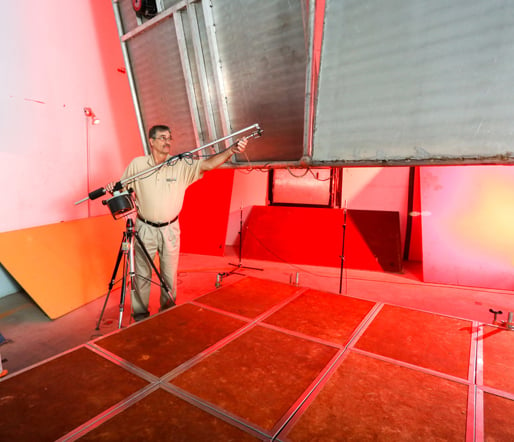
Acoustic Testing Services
Our acoustic test facility features nine full-scale, fully isolated independent test chambers complete with a sophisticated control room so multiple tests can be completed concurrently. With all these resources, we can provide quick turnarounds at an overall low cost.
We also have 50+ pre-built, movable, floor-ceiling acoustic test assemblies and regularly add more custom assemblies.
TEST CAPABILITIES
Acoustic Test Standards
Specifies the method for determining the Sound Power Level or sound energy level of a noise source from the sound pressure levels measured in a Reverberation Test Chamber. Sound Pressure Levels and Reverberation Room Absorption are measured to calculate the Sound Power being emitted from an operating unit under test.
Measures the airborne sound attenuating characteristics of Partitions, Floor-Ceiling assemblies, Windows, Doors, or Barrier Materials. This Transmission Loss data is used to establish the Sound Transmission Class (STC) rating of the unit being tested.
This method outlines a procedure to measure the ability of a Floor-Ceiling system to attenuate impact and vibrational transmission from an upper room to a lower room. It measures sound levels of this transmission in the lower room as a function of 1/3 Octave frequencies. A Standard Tapping Machine is used to provide the impact stimulation.
Using the 1/3 Octave measured data as per ASTM E492, this method identifies the procedure to use to calculate the single-number rating of Impact Insulation Class (IIC).
This method is intended to objectively measure the effectiveness that ceiling panels, wall panels, or office furniture units have on Speech Privacy when they are introduced into an Open Office environment. The data measured is used to calculate the Articulation Class (AC) as per ASTM E1110.
Defines a method to calculate OITC single-number ratings which evaluate the attenuation provided by Building Walls, Windows, and Doors to exterior airborne sound.
This method measures the attenuation provided by floor covering(s) on a standard 6-inch concrete floor. As it does for ASTM E492, the impacts are created by a Standard Tapping Machine. A single number rating, Delta IIC, is calculated using this measured data adjusted for levels measured for the Reference concrete floor.
Measures the sound absorption that materials, such as ceiling panels, office screens, unit absorbers, and curtains have. The measurements are made in a 10,000 ft3 Reverberation Room by measuring the decay rate both with and without a sample present. This data is used to calculate the Sound Absorption of a test specimen.
This method measures the sound absorption that materials, such as ceiling panels, office screens, unit absorbers, and curtains have. The measurements are made in a 10,000 ft3 Reverberation Room by measuring the decay rate both with and without a sample present. This data is used to calculate the Noise Reduction Coefficient (NRC) and Sound Absorption Average (SAA) of a test specimen.
Defines the method of calculating the single-number rating of STC using measured 1/3 Octave Band measurements of a unit’s sound attenuation properties as per ASTM E90.
Identifies the test specimen mountings that are to be used to perform Sound Absorption tests per ASTM C423. The intent of these mountings is to replicate as closely as possible the application of the materials being tested to their field application.
Method to calculate the single-number AC rating on the effectiveness of Open Office components for Speech Privacy. This method uses Interzone Attenuation data measured as per ASTM E1111.
For this test, a source generates a high sound level within a pipe. Measurements are made outside the pipe when it is bare and then when that pipe is lagged with a material/system. The Insertion Loss is calculated when these levels are compared.
This method measures the effectiveness of ceiling panels attenuating airborne sound between two adjacent rooms having a common open plenum between them. This standard can also be used to evaluate the effects that plenum barriers, ventilating systems, and luminaires may have when introduced into the ceiling system.
This classification provides methods for calculating single-number ratings of “high-frequency” impact sound transmission using the 1/3 octave bands from 400 to 3150 HZ, generated as per ASTM E492 and ASTM E2179.
Specifies a laboratory method for measuring the airborne sound insulation of building products, such as walls, floors, doors, windows, shutters, façade elements, and glazing.
Test procedure for determining the airborne sound insulation performance of materials and composite layers of materials commonly found in mobility, industrial, and commercial products.
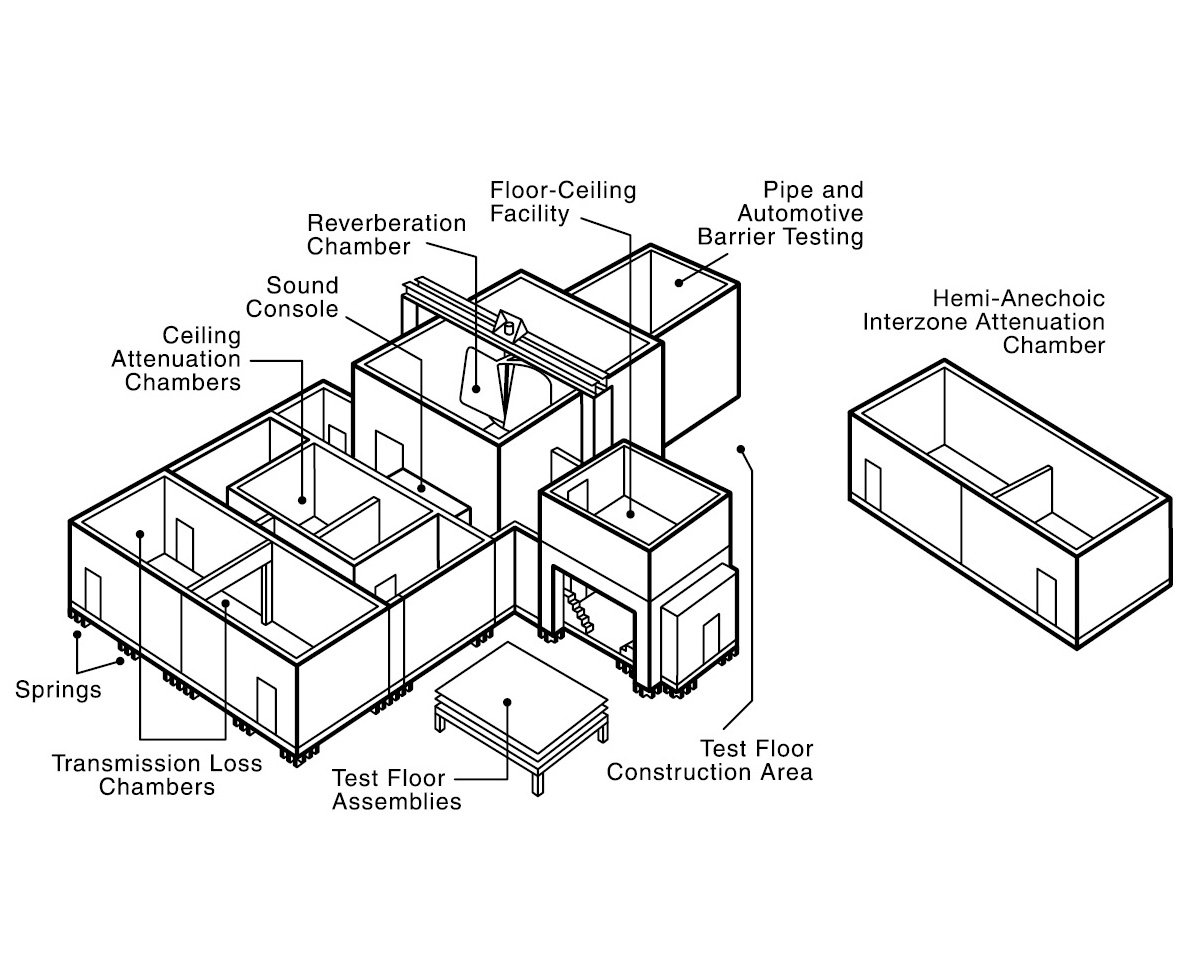
RESOURCE
Take a Closer Look at Our Acoustical Testing Complex
Our acoustic testing labs have been engineered to complete full-scale tests on a wide range of products. Download this map of our acoustic laboratory testing complex to take a closer look at our available facilities.
ACOUSTIC TESTING LABORATORIES
Our Acoustical Testing Facilities
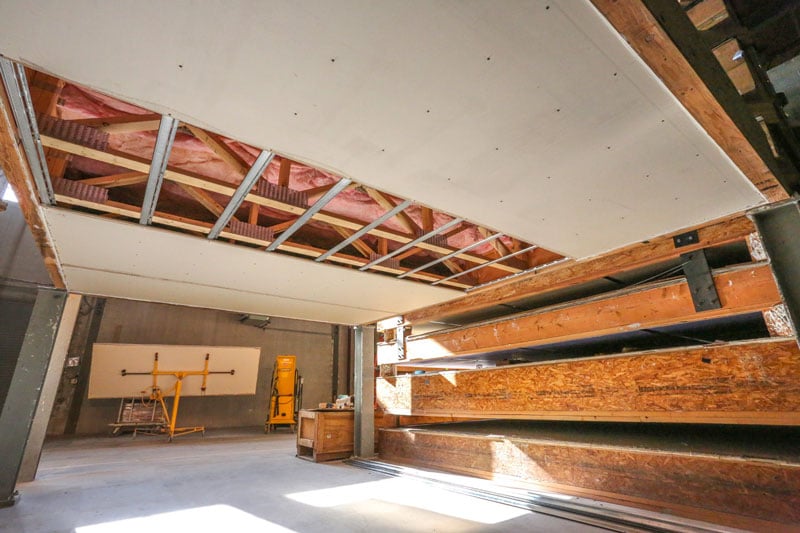
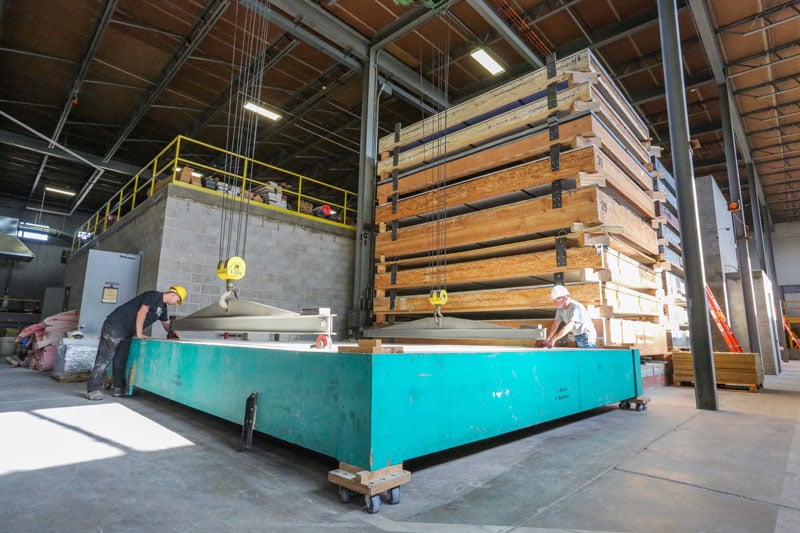
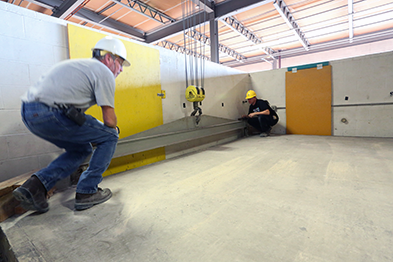
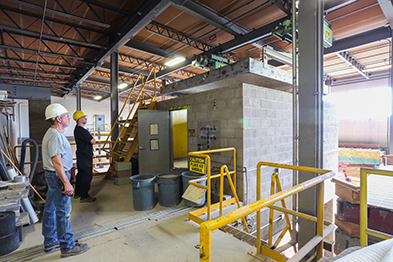
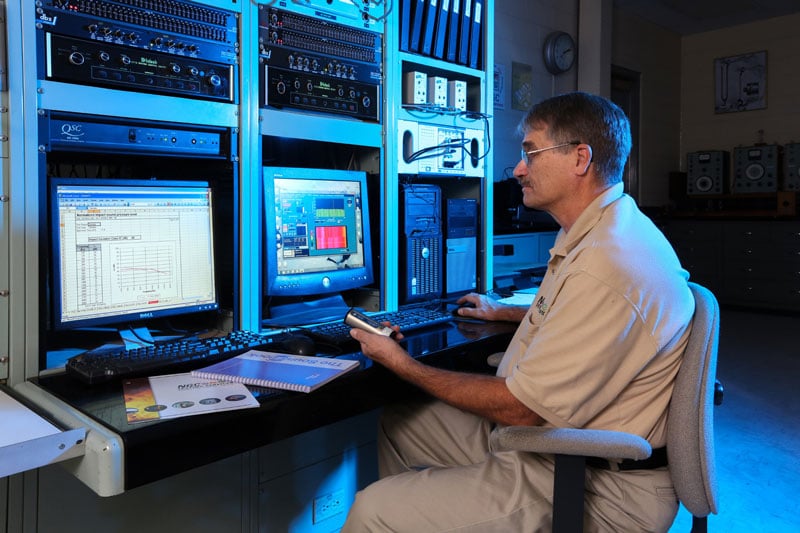
Partition Sound Transmission Loss Chambers
Sound Transmission Class (STC)
For evaluating:
- Partitions
- Building walls
- Doors
- Windows
- Barriers
Ceiling Attenuation Chambers
Ceiling Attenuation Class (CAC)
For evaluating:
- Ceiling tile
- Suspended-ceiling systems
Sound Absorption Chamber
Noise Reduction Coefficient (NRC)
For evaluating:
- Finishes
- Ceiling tile
- Insulation
- Office screens
- Space absorbers
- Baffles
- Curtains
Sound Transmission Chamber
Insertion loss of mechanical insulation products and sound transmission of smaller-scale test specimens
For evaluating:
- Pipe lagging systems
- Smaller-scale sound transmission tests
- Automotive barriers
Floor-Ceiling Chambers
Sound Transmission Class (STC), Impact Insulation Class (IIC), and Reduction in Impact Sound Transmission (Delta IIC)
Multiple test frame and overhead crane capabilities for evaluating:
- Floor-Ceiling assemblies
Hemi-Anechoic Test Chamber
Articulation Class (AC) for Open Office Components, Specialty Acoustic Measurements
For evaluating:
- Ceiling tile and systems
- Wall treatments
- Open office furniture/dividers
Miscellaneous
Additional facilities for developing custom test programs to evaluate acoustical performance of a wide range of products
BLOG ARTICLES
Stay Updated
The NGC Testing Services team has decades of experience providing efficient and cost-effective solutions for full-scale fire, structural/building envelope, analytical, and acoustic material testing. Stay up to date with our recent blog articles and sign up for our quarterly newsletter.
OTHER SERVICES
Additional Testing Services
Analytical/Physical Testing
Analytical testing in support of physical property testing of building materials and construction products for the built environment.
Fire Testing
Large and small-scale fire testing of building materials and assemblies. Compliant with appropriate ASTM, UL, NFPA, or UBC Standards.
Structural Testing
Full-scale shear, racking, weather, wind-load, and fenestration testing of building materials and exterior assemblies.
Additional Tests & Services
Information on our other tests and services to assist in test projects, including a description of facilities, equipment, and test services.
GET IN TOUCH
Schedule an Appointment
Have questions about our acoustic testing equipment or services? Ready to schedule a test? Reach out to an acoustic test engineer now.
